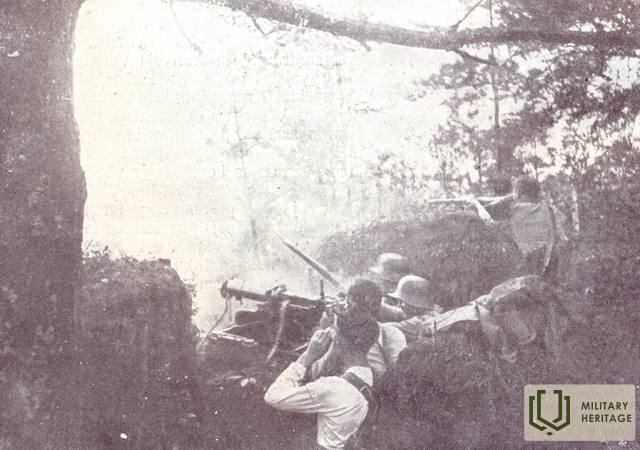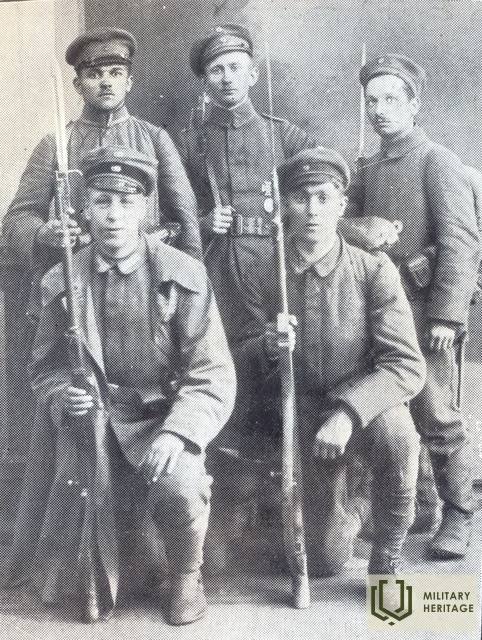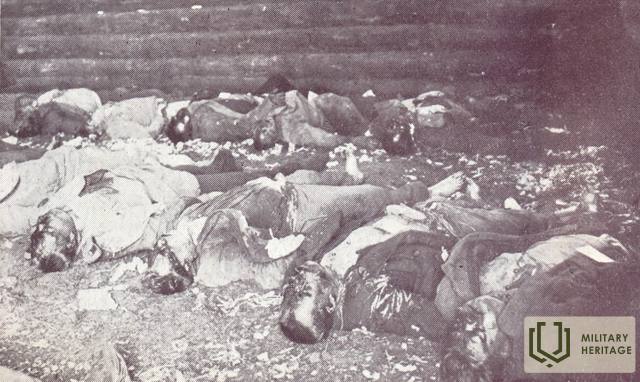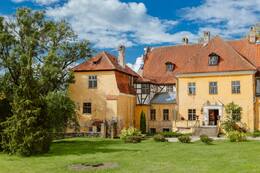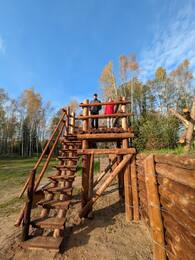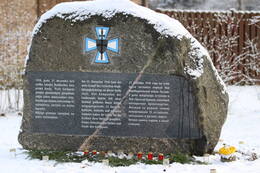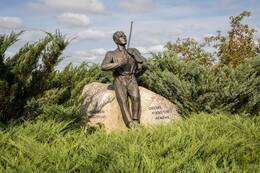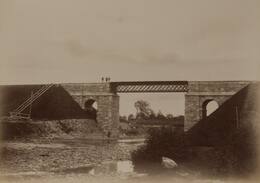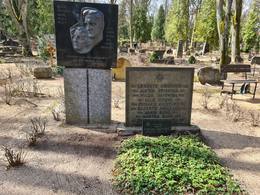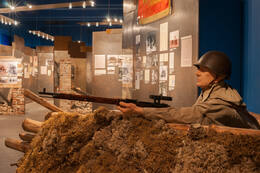Landesvērs. Baltijas landesvērs I Neatkarības kari
Landesvērs. Baltijas landesvērs (vācu: Baltische Landeswehr, krievu: Балтийский ландесвер, angļu: Baltic Land Defence, Baltic Territorial Army, Baltic Home Guard)
Baltijas landesvērs bija Vācijas okupēto Baltijas provinču iedzīvotāju pašaizsardzības struktūra, kuras organizēšanas priekšdarbi tika uzsākti 1918. gada rudens sākumā, bet novembra otrajā pusē to iekļāva jaundibinātās Latvijas Republikas bruņotajos spēkos - Latvijas zemessardzē (vācu: die Lettländische Landeswehr) sarunvalodā saukta par "landesvēru" vai "Baltijas landesvēru".
Multietniskā (vācbaltieši, latvieši, krievi) "Latvijas zemessardze", ar Vācijas militāro atbalstu kļuva par Latvijas bruņotajiem spēkiem. Administratīvi to pakļāva Latvijas Apsardzības ministram Jānim Zālītim, bet apgādes un militārā ziņā — Vācijas okupācijas spēku vadībai. Latvijas valdības un Vācijas pārstāvja Augusta Vinniga līgums paredzēja zemessardzi veidot uz brīvprātības pamatiem no 18 latviešu, 7 vācu un vienas krievu rotas, zemessardzes komandierim pēc sākotnējā plāna bija jābūt kādas neitrālas valsts (Zviedrijas) pārstāvim, taču tas neīstenojās. Jau novembra beigās Vinnigs no aizejošā vācu karaspēka karavīriem bija izveidojis Dzelzsbrigādi (vēlāko Dzelzsdiviziju), kuras kareivjiem pēc decembra līguma bija iespēja saņemt Latvijas pavalstniecību un zemi.
Vācieši un vācbaltieši turpināja karaspēku saukt par Baltijas landesvēru, nevis Latvijas zemessardzi. Latviešu rotas, kas sāka veidoties landesvēra ietvaros, savus nosaukumus veidoja pēc formēšanas vietas nosaukuma (Rīgas, Cēsu, Jelgavas, Latgales) vai sastāva (Virsnieku, Studentu). Par latviešu vienību komandieri tika iecelts apakšpulkvedis Oskars Kalpaks.
Februāra sākumā Liepājā ieradās ģenerālis Rīdigers fon der Golcs. Viņš tika iecelts par vācu bruņoto spēku (kurā ietilpa Baltijas landesvērs un Dzelzsdivīzija) pavēlnieku Kurzemē un Ziemeļlietuvā, kā arī par Liepājas gubernatoru. 1919. gada 16. aprīlī Golcam pakļautās karaspēka daļas Liepājā īstenoja pret Latvijas Pagaidu valdību vērstu apvērsumu.
Vācbaltieši, kas bija apvienojušies Baltijas landesvērā, dažādos Neatkarības kara posmos gan atbalstīja Latvijas Tautas padomes izveidoto Pagaidu valdību ar Kārli Ulmani priekšgalā, gan karoja pret to, kad nostājās nelikumīgās Andrieva Niedras valdības pusē. Ja sākotnēji gan vācu, gan latviešu vienībām bija kopējs mērķis – atbrīvot Latviju no lieliniekiem, tad pēc Rīgas atbrīvošanas 1919. gada maijā, landesvēra un vācu Dzelzdivizijas karadarbība bija vērsta nevis pret lieliniekiem, bet gan pret likumīgai Latvijas pagaidu valdībai uzticīgo Ziemeļlatvijas karaspēku un Igaunijas armiju. Pēc Cēsu kaujām, kurās tika sakauts landesvērs un Dzelzsdivizija, Latvijas valstij lojālās landesvēra vienības turpināja cīņu pret lieliniekiem. 1920. gada 30. martā landesvēru pārveidoja par 13.Tukuma kājnieku pulku un iekļāva Kurzemes divīzijā. 1922. gada 1. aprīlī pulku likvidēja, kareivjus pievienojot 7. Siguldas kājnieku pulkam.
Pazīstamākie landesvēra komandieri bija Alfreds Flečers (1919. gada 1. februāris—12. jūlijs) un Harolds Aleksanders (1919. gada 12. jūlijs—1920. gada 18. februāris)
Papildus izziņas avoti
Ēriks Jēkabsons. Latvijas Neatkarības karš. Latvijas Pagaidu valdības un tās bruņoto spēku cīņa par Latvijas neatkarības nodrošināšanu 18.11.1918.-11.08.1920.gadā. – Nacionālā enciklopēdija: https://enciklopedija.lv/skirklis/22216-Latvijas-Neatkar%C4%ABbas-kar%C5%A1
Cīņa par brīvību: Latvijas Neatkarības karš (1918–1920) Latvijas Valsts vēstures arhīva dokumentos, 1. daļa, 1918. gada 18. novembris–1919. gada 16. aprīlis, sast. Ē. Jēkabsons un J. Šiliņš, Rīga, Latvijas Nacionālais arhīvs, 2019.
Cīņa par brīvību: Latvijas Neatkarības karš (1918–1920) Latvijas Valsts vēstures arhīva dokumentos” 2. daļa. 1919. gada 16. aprīlis–10. jūlijs, sast. Ē. Jēkabsons un J. Šiliņš, Rīga, Latvijas Nacionālais arhīvs, 2019.
Latvijas brīvības cīņas (skat.literatūra un ārējās saites). Vikipēdijas lapa: https://lv.wikipedia.org/wiki/Latvijas_br%C4%ABv%C4%ABbas_c%C4%AB%C5%86as
Saistītās laikalīnijas
Saistītie objekti
Piemineklis pieminot 1919. gadā Landesvēra nošautos carnikaviešus
Atrodas Carnikavas parka DR stūrī pie Jūras ielas un Nākotnes ielas krustojuma starp diviem ozoliem.
Granīta piemineklis 12 carnikaviešiem, kurus 1919. gada pavasarī nogalināja vācu landesvēra vienības par it kā “sarkanā pulciņa” apmeklēšanu.
Lielstraupes pils
Atrodas Straupes centrā
Cēsu kauju laikā Lielstraupes pilī atradās Dzelsdivīzijas (vācu: Eiserne Division) Paula Ludviga Evalda fon Kleista kaujas grupas komandpunkts.
Kauju laikā to apmeklēja majors Bišofs, kapteinis Guderiāns u.c. No pils tika vadīts uzbrukums Stalbes virzienā 21.-22. jūnijā.
Dzelzsdivīzija bija Vācijas algotņu karaspēks Latvijas Brīvības cīņu laikā, ko izveidoja no demobilizētās Vācijas impērijas 8. armijas kareivjiem un brīvprātīgiem algotņiem. Tā bija pazīstamākā vācu brīvkorpusu daļa un viena no labāk apmācītajām un kaujasspējīgākajām karaspēka daļām Baltijā 1919. gadā.
Padomju varas gados, no 1949. līdz 1959. gadam muižas pilī atradās un darbojās Lielstraupes mašīnu traktoru stacijas pārvalde. Šajā laikā pilī tika ierīkotas arī mācību telpas un traktoristu kopmītnes, bet bijušajā muižas stallī atradās darbnīcas.
No 1963. līdz 2018.gadam pili apsaimniekoja medicīnas iestādes, un par Straupes narkoloģisko slimnīcu Latvijā mēdza teikt, ka te “ārstē pat sienas”.
Tagad pils ir atvērta apskatei un apmeklētājiem tā piedāvā ceļojumu cauri gadsimtiem kopā ar orientēšanos pils labirintos.
Ziemassvētku kauju muzejs
Muzejs atrodas Jelgavas novada Valgundes pagasta “Mangaļu” mājās un ir Latvijas Kara muzeja filiāle. Tas atklāts 2005. gadā vietā, kur Pirmā pasaules kara laikā norisinājās Ziemassvētku kaujas. Cīņu vietās joprojām ir saglabājušies unikāli Pirmā pasaules kara nocietinājumi. Ziemassvētku kauju muzeja brīvdabas ekspozīcijā autentiskā vietā rekonstruēts nocietinājumu sistēmas posms - blindāža un daļa no vācu aizsardzības pirmās līnijas - „vācu vaļņa”, kas ir vienīgais šāda veida objekts Baltijā.
Ziemassvētku kaujas ir viens no zināmākajiem un dramatiskākajiem Pirmā pasaules kara notikumiem Latvijā. Tās ieņem īpašu vietu latviešu militārajā un kultūras vēsturē. Intensīvas kaujas norisinājās sešas dienas un noveda pie lieliem zaudējumiem. Cīņas galvenokārt asociējas ar latviešu strēlnieku uzbrukumu Vācijas armijas vienībām, kas notika īpaši skarbos un nelabvēlīgos ziemas apstākļos. Tas ir nebijis gadījums, kad vērienīga kaujas operācija tika uz sākta bez artilērijas atbalsta.
Mūsdienās muzejā var aplūkot kauju vietās atrastus priekšmetus. Iekštelpu ekspozīcija pieejama noteiktos laikos, savukārt brīvdabas fortifikāciju ekspozīcija – katru dienu. Apkārtnē izveidoti tūrisma maršruti un izziņas takas.
2025. gada rudenī muzeja āra teritorija tika atklāta pēc rekonstrukcijas darbiem. Ir atjaunots Vācu valnis ar blakus esošajiem fortifikācijas elementiem, izvietots vēsturiskais lielgabals un granātmetēja replika, apskatāms vēsturiskā dzelzceļa fragments, uzstādīti jauni informācijas stendi, pieejama pielāgota wc u.c.
Piemineklis pirmajai kaujai par Latvijas neatkarību
Atroadas, Inčukalnā, Atmodas ielā 2.
2016.gada 3.jūlijā, tika atklāts piemineklis pirmajai kaujai par Latvijas neatkarību, kas veltīts Latvijas zemessardzei (Die Lettländische Landeswehr), kurā plecu pie pleca jaundibināto valsti pret boļševiku Sarkano armiju aizstāvēja vietējie baltvācieši, krievi un latvieši, kuri tolaik gan bija vienībās abās pusēs. Brāļu kapu komitejas priekšsēdētājs Eižens Upmanis tolaik secinājis, ka kauju piemiņas vietās ārpus kapiem šis varētu būt vēsturiski pirmais piemineklis apvienotajiem latviešu un baltvāciešu spēkiem. Tajā laikā par Latvijas zemessardzes jeb landesvēra latviešu vienību komandieri iecēla pulkvežleitnantu Oskaru Kalpaku, no kura vienībām Brīvības cīņu gaitā izaugusi un veidojusies vēlākā Latvijas armija.
1918.gadā visa tagadējās Latvijas teritorija bija nonākusi Vācijas impērijas un tās karaspēka rokās. Tomēr 1918.gada vasaras beigās un rudenī situācija sāka strauji noslēgties Vācijai par sliktu un bija skaidrs, ka tas ir tikai laika jautājums, kad Vācija būs spiesta atzīt sakāvi 1.Pasaules karā. Krievijas impērija, kurā Latvija ietilpa līdz 1. Pasaules karam, bija beigusi pastāvēt jau agrāk, līdz ar 1917.gada februāra un oktobra revolūcijām. 1918.gada 18.novembrī tika proklamēta Latvijas Republika. Vācijas armija, kas atradās Latvijas teritorijā, pēc pamiera noslēgšanas ar Antantes valstīm 1918.gada 11.novembrī, vairs nebija motivēta turpmākai karadarbībai un lielākā daļa tās karavīru vēlējās vienkārši atgriezties dzimtenē.
Pie šādiem apstākļiem bija skaidrs, ka Latvijas aizsardzība ir atkarīga pirmkārt no pašas Latvijas iedzīvotāju veidotas zemessardzes. Sākotnēji, pateicoties izglītotībai un salīdzinoši lielākai spējai pašorganizēties, vislielāko iniciatīvu šādas zemessardzes veidošanā izrādīja Latvijā dzīvojošie vācbaltieši. Tāpat zemessardzei pievienojās arī krievu tautības karavīri. Lai nodrošinātu zemessardzes apgādi ar uniformām, ieročiem un citiem nepieciešamajiem resursiem, Latvijas Pagaidu valdība 1918.gada 7.decembrī noslēdza līgumu ar Vācijas pārstāvi Augustu Vinnigu, paredzot zemessardzes nodrošinājumu no Latvijas teritorijā esošajām Vācijas armijas rezervēm. Šis līgums cita starpā norādīja, ka šī zemessardze ar oficiālo nosaukumu – „Latvijas zemessardze” jeb vāciski – „die Lettländische Landeswehr” būs Latvijas Republikas bruņotie spēki.
Pretīm Latvijas zemessardzei stājās divi līdz tam 1. Pasaules karā un Krievijas pilsoņu karā pieredzējušie Latviešu sarkano strēlnieku pulku karavīri (t.i. aptuveni 2000 – 3000 karavīru sastāvā). Neskatoties uz Sarkanās armijas pieredzes un skaitlisko pārsvaru, Latvijas zemessardze sīvās kaujās noturēja Inčukalnu divas dienas, līdz beidzot 1919.gada 1.janvāra vakarā, lai izvairītos no ielenkuma, bija spiesta atkāpties, zaudējot 43 kritušos, kā arī vairākus ievainotos, no kuriem lielākā daļa nonāca lielinieku gūstā, kur tika nogalināti vai nomira no bada vai slimībām.
Autors: Artis Buks. Materiāls: Laukakmens. Piemineklis izgatavots no liela izmēra monolīta akmens, kas tika atrasts Ruļļos pie Jelgavas.
Pulkveža O. Kalpaka dzimtās mājas “Liepsalas”
Atrodas “Liepsalas”, Ošupes pagastā, Madonas novadā.
Pulkveža Oskara Kalpaka dzimtas piemiņvieta "Liepsalas" izveidotas 1997. gadā ar pulkveža brāļameitas Ārijas Kalpaks - Grundmanes (1922-2006) idejām un līdzekļiem. Piemiņas vietu veido dažādi vides objekti un akmens skulptūras ar simbolisku nozīmi, kas raksturo latviešu ētiskās un patriotiskās vērtības. Lielākajā ēkā iekārtota ekspozīcija, kas veltīta Latvijas brīvības cīņu un Latvijas brīvības 22 gadu (1918-1940) vēsturei.
Piemiņas memoriālā iekārtoti vairāki vides elementi un objekti:
* Svētklētiņa – pateicība Dievam, Svēto rakstu gara maize.
* Karogs mastā, Auseklīša zvaigznes centrā, balstoties uz vārdiem Dievs, Latvija, Zemnieks, Karavīrs.
* Lūgšanu akmens garīgam spēkam – tas visu spēj, kas lūdz un tic. Domu graudi priekam, mīlestībai, cerībai – Pārdomu taciņas.
* Dzimtas ozols ar trīs ozollapu liecībām (akmenī) mūžīgiem cienītājiem – dzīvojamās mājas vietā.
* Skulptūra. Trīs mūža draugi – jauneklis, vijole un akmens.
* Ēka (uz bijušās kūts mūriem) – no jauna būvēta ēka.
* Muzejs – brīvības cīņu un Latvijas brīvības 22 gadu (1918 – 1940) vēsture audio un video sniegumā.
* Zirgu staļļa un vāgūža vietas iezīmējums akmeņu stāstījumā.
* Pirtiņa, aka – veselībai un spirdzinājumam. Siena šķūnīši pārnakšņošanai.
* Sakņu kambari, malkas šķūnītis.
* Labības šķūnis un rija – pulcēšanās un deju laukums ar skatuvi, krāsns – pavarda vieta sabiedriskiem pasākumiem, kultūrai, izklaidēm, tradīcijām, Tēvzemes mīlestības celsmei visām paaudzēm.
* Dzimtas puķu dārzs – dievišķam skaistumam.
* Starp senču ozoliem – akmens baraviku saimes grupa.
* Skulptūru dārzs – Dievs, Latvija, Zemnieks, Karavīrs – mākslinieku dāvinājumi.
* Piemiņvietas apzīmējuma vārti akmens un dzelzs veidojumā, ar vadmotīvu “Dievam, Tēvzemes mīlestības celsmei” – veltījums un dāvinājums latviešu tautas jaunatnei.
* Bērzu birzīte un divi dīķi – tā, kā bija Latvijas ziedu laikos. Birzīti 1936. gadā stādījuši pulkveža Oskara Kalpaka Meirānu pamatskolas skolēni.
* Ozolu aplis un liepu aplis savienots ar Vienotības taku “Drošībai, Darbam, Draudzībai, Daudzinājumam”.
Liepaslās netiek atjaunota gandrīz 300 gadus vecā zemnieku saimnieciskā sēta, bet veidota piemiņvieta – kā patriotiskās audzināšanas svētvieta un spēkavots. Ozols arvien bijis zemnieku un karavīru simbols, liepa – ģimenes dvēsele un saimniece, pavarda sargātāja. Apļa simbols – ozoldēli, liepu meitas – mūsu tautā stiprināmais senču gars, garīgais spēks – latviešu pašapziņa. Atziņu, padoma teksti rakstīti akmenī.
Dzelzceļa tilts pār Amatu
Atrodas Drabešu pagastā, Cēsu novadā, netālu no atpūtas vietas "Meža kaujas".
Redzams dzelzceļa tilts pār Amatu.
Dzelzceļa tiltam pār Amatu ir ļoti svarīga nozīme visā Neatkarības kara gaitā, jo te 1919.gada 5. jūnijā notika Igaunijas armijas bruņoto vilcienu pirmā kauja ar Baltijas landesvēra vienībām. Landesvērs, zinot, ka tuvojas bruņotais vilciens, nomīnēja dzelzceļa tiltu un ieņēma pozīcijas “Amatas” mājās upes krastā, esot gatavībā iespējamajai karadarbībai. Tilts pār Amatu bija robeža starp igauņu spēkiem un vāciešiem.
Vēsturiskās liecības par notikumiem pie Amatas tilta nav saglabājušās. Tā kā šajos notikumos latvieši nepiedalījās, nav viņu atmiņu stāstījumu, ir atmiņas no igauņu karavīriem, citiem avotiem. Var teikt, ka šī bija igauņu – amerikāņu kopīga kauja pret landesvēru, jo igauņu bruņotajā vilcienā atradās amerikāņu virsnieks, kurš vēlāk karoja arī 2.pasaules karā. Kopumā Cēsu kaujās piedalījās daudzi nākamie 2.pasaules kara virsnieki, komandieri, īpaši vācu pusē.
Igauņu bruņotais vilciens Cēsīs ieradies 1919.gada 2.jūnijā, dienu vēlāk devies uz Ieriķiem, kur notikušas sarunas ar landesvēru, kas bija bez rezultātiem, un 5.jūnijā, kad bruņotais vilciens atkal tuvojās Amatas tiltam, sākās sadursme ar vāciešiem. Bruņotais vilciens dienu vēlāk iesaistījās arī kaujās pie Cēsīm, kur palīdzēja Skolnieku rotas karotājiem, kuriem draudēja aplenkums. Lai arī vācieši centās izjaukt sliedes, lai nogrieztu vilcienam atkāpšanās ceļu, tam izdevās atkāpties pāri Raunas tiltam.
1919.gada naktī uz 23. jūniju, Cēsu kauju laikā, landesvērs pameta Cēsis un atkāpās uz Amatas upes līniju. Atkāpjoties vācieši nodedzināja Cēsu latviešu biedrības namu un uzspridzināja tiltu pār Amatu.
Piemineklis pirmajam Skolnieku rotas kritušajam karavīram Edgaram Krieviņam
Atrodas Valmieras pilsētas Centra kapos, netālu no kapličas (Miera iela 1/3, Valmiera)
Cēsu pulka 8. (Skolnieku) rotas karavīrs, LKOK Edgars Krieviņš (1899-1919), miris 7. jūnijā no ievainojumiem, kas tika gūti Cēsu kaujās 1919. 6. VI., kad, landasvēram uzbrūkot, viņš sedza pārējo daļu atiešanu.
Latvijas Kara muzejs
Atrodas Vecrīgā netālu no Brīvības pieminekļa un izvietots senā aizsardzības būvē.
Latvijas Kara muzejs ir viens no vecākajiem Latvijas muzejiem. Tā pirmsākumi meklējami 1. pasaules kara laikā. Muzeja krājums tika veidots galvenokārt no kaujas laukā iegūtām un karavīru personīgajām lietām. Kopš 1919. gada muzeja telpas atrodas Pulvertornī. Pēc Latvijas valsts izveides par muzeja galveno mērķi kļuva ekspozīcijas izveide par Latvijas militāro vēsturi un iedzīvotāju aktīvo lomu savas zemes aizsardzībā. 1937.gadā muzejs tika paplašināts ar piebūvi. Ēka tika celta speciāli tā vajadzībām — tehniski viens no modernākajiem tā laika muzejiem Eiropā.
Pulvertornis ir viens no bijušajiem Rīgas nocietinājumu torņiem. Tas pieminēts 1330. gadā kā Smilšu tornis. 1621.gadā, kad Rīgu aplenca Zviedrijas karaspēks, torni sagrāva. 1650. gadā tika uzbūvēts jauns tornis, šaujampulvera un ieroču glabāšanai. Pēc pilsētas nocietinājumu nojaukšanas Pulvertornis ir viena no vērtīgākajām liecībām par Rīgas aizsardzības sistēmu.
Muzejā var aplūkot 11 ekspozīcijas. Izstādīti dažādi ieroči, dokumenti, formas tērpi, apbalvojumi un citi ar karu vai karavīru ikdienu saistīti priekšmeti.
Saistītie stāsti
Cēsu kauju sākums, notikumu gaita un noslēgums
Gūtajai uzvarai Cēsu kaujās bija lemts kļūt par pagrieziena punktu latviešu un igauņu cīņā par savas valsts neatkarību. Šī uzvara pārvilka svītru Andrieva Niedras valdības un Vācijas ģenerāļa Rīdigera fon der Golca Baltijas iekarošanas plāniem. Tā vietā savu darbību Liepājā atjaunoja Kārļa Ulmaņa Latvijas Pagaidu valdība.
Par nacionālo patriotu virsleitnantu Vili Gelbi
Virsleitnanta Viļa Gelbes (1890-1919) liktenis atspoguļo sarežģīto situāciju mūsu valsts un armijas tapšanā, kā arī šo notikumu novērtējumā.
Līdz ar Latvijas valsts proklamēšanu 1918. gada 18. novembrī sākās arī tās Neatkarības karš un bruņoto spēku veidošanas darbs. Brīvprātīgo latviešu karavīru pirmajās rindās bija Kurzemē dzimušais jūras virsleitnants Vilis Gelbe.
Aizporu pusmuiža Neatkarības karā
Aizporu pusmuiža, Aizputes novada, Kalvenes pagastā ir tālākā Latvijas vieta rietumos, līdz kurienei atkāpās pulkveža Oskara Kalpaka atsevišķais bataljons.
Pusceļā starp Rudbāržiem un Kalveni, autoceļa malā, atrodas Aizpores kapi. Tajos izvietots piemineklis un 12 piemiņas zīmes apkārtējo māju iedzīvotājiem - brīvprātīgajiem Oskara Kalpaka bataljona karavīriem.




